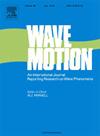螺旋波导的导模
IF 2.5
3区 物理与天体物理
Q2 ACOUSTICS
引用次数: 0
摘要
本文研究了在螺旋螺旋波导中传播的波导横向标量模。将模式建模为三维波导几何结构中的亥姆霍兹方程的解,将寻模问题转换为三维二次特征问题。通过解扭曲映射,表明该问题等价于一个三维二次特征问题。接下来,利用螺旋结构的恒定扭转和曲率,将三维特征问题进一步简化为波导截面上的二维特征问题。所有三个特征问题都进行了数值处理。正如预期的那样,在2D模型中实现了显著的计算节省。为了使三维几何中的模态计算可行,需要一些重要的数值技术。它们与有效滤除不需要的非传播特征函数的过程一起提出。计算结果表明,卷取的几何效应是使导模的定位偏离卷取中心。本文以卷绕式光纤为例,报道了卷绕式光纤模式随螺距变化的变化规律。本文章由计算机程序翻译,如有差异,请以英文原文为准。
Guided modes of helical waveguides
This paper studies guided transverse scalar modes propagating through helically coiled waveguides. Modeling the modes as solutions of the Helmholtz equation within the three-dimensional (3D) waveguide geometry, a propagation ansatz transforms the mode-finding problem into a 3D quadratic eigenproblem. Through an untwisting map, the problem is shown to be equivalent to a 3D quadratic eigenproblem on a straightened configuration. Next, exploiting the constant torsion and curvature of the Frenet frame of a circular helix, the 3D eigenproblem is further reduced to a two-dimensional (2D) eigenproblem on the waveguide cross section. All three eigenproblems are numerically treated. As expected, significant computational savings are realized in the 2D model. A few nontrivial numerical techniques are needed to make the computation of modes within the 3D geometry feasible. They are presented along with a procedure to effectively filter out unwanted non-propagating eigenfunctions. Computational results show that the geometric effect of coiling is to shift the localization of guided modes away from the coiling center. The variations in modes as coiling pitch is changed are reported considering the example of a coiled optical fiber.
求助全文
通过发布文献求助,成功后即可免费获取论文全文。
去求助
来源期刊

Wave Motion
物理-力学
CiteScore
4.10
自引率
8.30%
发文量
118
审稿时长
3 months
期刊介绍:
Wave Motion is devoted to the cross fertilization of ideas, and to stimulating interaction between workers in various research areas in which wave propagation phenomena play a dominant role. The description and analysis of wave propagation phenomena provides a unifying thread connecting diverse areas of engineering and the physical sciences such as acoustics, optics, geophysics, seismology, electromagnetic theory, solid and fluid mechanics.
The journal publishes papers on analytical, numerical and experimental methods. Papers that address fundamentally new topics in wave phenomena or develop wave propagation methods for solving direct and inverse problems are of interest to the journal.
 求助内容:
求助内容: 应助结果提醒方式:
应助结果提醒方式:


